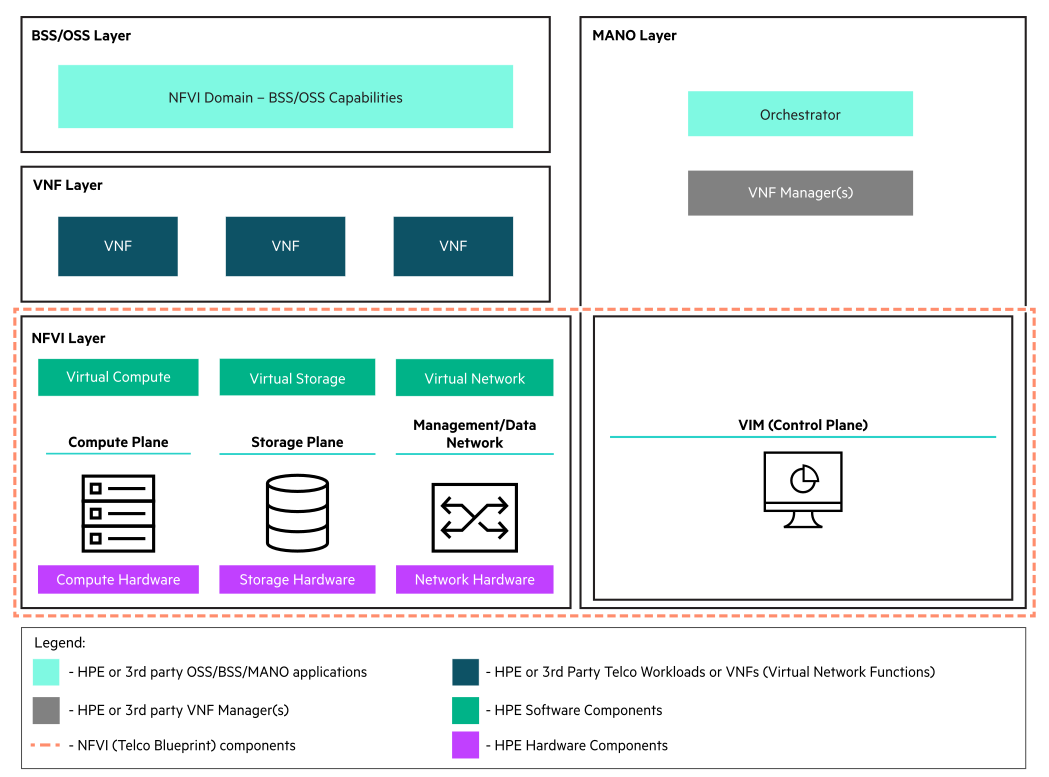HPE Telco Blueprint logical architecture
- Network Plane
- Switches:
Management switches
Data switches
- NICs:
Management NIC
Data NIC
- Network configuration:
VxLAN (Virtual extensible local area network)
For more information on the specific hardware validated for control plane (Undercloud host and VIM controller), compute, storage, hyperconverged infrastructure, and switches (management and data), see HPE Telco Blueprint hardware components.

The number of servers mentioned in the block diagram applies to the HPE Telco Blueprint Starter Kit only. Additional compute nodes can be added for scale out using the Compute Expansion Kits.
The Third-Party Hardware and WAN Network components (in gray color) are not included in the Core Telco Blueprint.
The Telco Blueprint solution with VMware vCloud NFV Openstack can be deployed using Two-Pod or the Three-Pod configuration:
Automation is supported for Two-Pod Configuration.
Two-Pod Configuration
A Two-Pod architecture consists of one cluster for the Management Pod and another cluster for the combined Edge & Resource Pod. The components of a typical Two-Pod architecture are as follows:
Management Pod: This cluster provides management services and hosts Virtualized Infrastructure Management (VIM) or operation related components. All the components are accessible through management network only.
Resource Edge Pod: This Pod provides compute, network, and storage to accomplish workloads in a virtualized runtime environment. It combines the NSX Edge Node to participate in the East-West traffic and to provide connectivity to the physical infrastructure for North-South traffic management capabilities.
Storage plane: The VMware Virtual SAN (vSAN) is used to implement software-defined storage for the Management and Resource clusters.
- Network plane: The network plane consists of the following switch options:
Management switch: HPE FlexFabric 5900 are used for Out-of-Band Management (OOBM) networking, for example, iLO.
Data switch: HPE StoreFabric SN2100M ONIE Power to Connector Airflow Half Width Switch.
For more information about the Two-Pod network architecture, see HPE Telco Blueprint Network Architecture.
Three-Pod Configuration
The Three-pod design separates the functional blocks by using a Management pod, an Edge pod, and a Resource pod, each for their respective functions. The components of Three-Pod architecture are as follows:
Management Pod: This cluster provides management services and hosts Virtualized Infrastructure Management (VIM) or operation related components. All the components are accessible through management network only.
Resource Pod: Virtual Network Functions are placed in the Resource Pod that forms the virtual network services.
Edge Pod: The Edge Pod provides the fabric for North-South connectivity to the provider networks.
Storage plane: The VMware Virtual SAN (vSAN) is used to implement software-defined storage for the Management and Resource clusters.
- Network plane: The network plane consists of the following switch options:
Management switch: HPE FlexFabric 5900 are used for Out-of-Band Management (OOBM) networking, for example, iLO.
Data switch: HPE StoreFabric SN2100M ONIE Power to Connector Airflow Half Width Switch.
The Three-Pod network architecture is pictorially represented in HPE Telco Blueprint Network Architecture. For more information on Three-Pod architecture, see Reference Architecture section in VMware vCloud NFV Product Documentation.
Switch connectivity
The HPE Telco Blueprint provides a VxLAN-based networking solution that includes, leaf (or data) switches, border leaf switches, and spine switches. For more detailed information, see HPE Telco Blueprint Network Architecture.